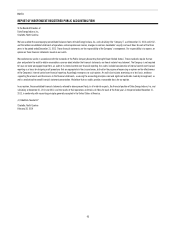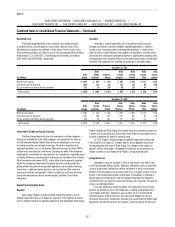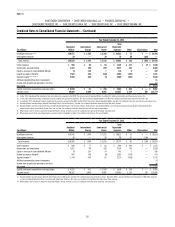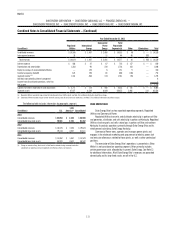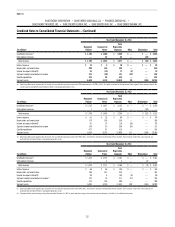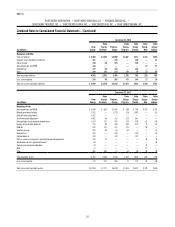Duke Energy 2013 Annual Report Download - page 122
Download and view the complete annual report
Please find page 122 of the 2013 Duke Energy annual report below. You can navigate through the pages in the report by either clicking on the pages listed below, or by using the keyword search tool below to find specific information within the annual report.
104
PART II
DUKE ENERGY CORPORATION • DUKE ENERGY CAROLINAS, LLC • PROGRESS ENERGY, INC. •
DUKE ENERGY PROGRESS, INC. • DUKE ENERGY FLORIDA, INC. • DUKE ENERGY OHIO, INC. • DUKE ENERGY INDIANA, INC.
Combined Notes to Consolidated Financial Statements – (Continued)
future cash ows, selection of discount rates and cost escalation rates, among
other factors. These estimates are subject to change. Depreciation expense is
adjusted prospectively for any changes to the carrying amount of the associated
asset. The Duke Energy Registrants receive amounts to fund the cost of the
asset retirement obligation for regulated operations through a combination of
regulated revenues and NDTF. As a result, the net of amounts recovered in
regulated revenues, earnings on the NDTF, accretion expense and depreciation
of the associated asset is deferred as a regulatory asset or liability.
Obligations for nuclear decommissioning are based on site-specic cost
studies. Duke Energy Carolinas and Duke Energy Progress assume prompt
dismantlement of the nuclear facilities after operations are ceased. Duke Energy
Florida assumes Crystal River Nuclear Station – Unit 3 (Crystal River Unit 3) will
be placed into a safe storage conguration until eventual dismantlement begins
in approximately 60 years. Duke Energy Carolinas, Duke Energy Progress and
Duke Energy Florida also assume that spent fuel will be stored on site until such
time that it can be transferred to a U.S. Department of Energy (DOE) facility.
See Note 9 for further information.
Revenue Recognition and Unbilled Revenue
Revenues on sales of electricity and gas are recognized when service is
provided. Unbilled revenues are recognized by applying customer billing rates to
the estimated volumes of energy delivered but not yet billed. Unbilled revenues
can vary signicantly from period to period as a result of seasonality, weather,
customer usage patterns and meter reading schedules.
Unbilled revenues are included within Receivables and Restricted
receivables of variable interest entities on the Consolidated Balance Sheets as
shown in the following table.
December 31,
(in millions) 2013 2012
Duke Energy $ 937 $ 920
Duke Energy Carolinas 323 315
Progress Energy 189 187
Duke Energy Progress 120 112
Duke Energy Florida 69 74
Duke Energy Ohio 55 47
Duke Energy Indiana 5 3
Additionally, Duke Energy Ohio and Duke Energy Indiana sell, on a
revolving basis, nearly all of their retail and wholesale accounts receivable,
including receivables for unbilled revenues, to an afliate, Cinergy Receivables
Company, LLC (CRC) and account for the transfers of receivables as sales.
Accordingly, the receivables sold are not reected on the Consolidated Balance
Sheets of Duke Energy Ohio and Duke Energy Indiana. See Note 17 for further
information. These receivables for unbilled revenues are shown in the table
below.
December 31,
(in millions) 2013 2012
Duke Energy Ohio $89 $90
Duke Energy Indiana 144 132
Allowance for Doubtful Accounts
Allowances for doubtful accounts are presented in the following table.
December 31,
(in millions) 2013 2012 2011
Allowance for Doubtful Accounts
Duke Energy $ 30 $ 34 $ 35
Duke Energy Carolinas 3 3 3
Progress Energy 14 16 27
Duke Energy Progress 10 9 9
Duke Energy Florida 4 7 18
Duke Energy Ohio 2 2 16
Duke Energy Indiana 1 1 1
Allowance for Doubtful Accounts — VIEs
Duke Energy $ 43 $ 44 $ 40
Duke Energy Carolinas 6 6 6
Derivatives and Hedging
Derivative and non-derivative instruments may be used in connection
with commodity price, interest rate and foreign currency risk management
activities, including swaps, futures, forwards and options. All derivative
instruments except those that qualify for the normal purchase/normal sale
(NPNS) exception are recorded on the Consolidated Balance Sheets at their
fair value. Qualifying derivative instruments may be designated as either cash
ow hedges or fair value hedges. Other derivative instruments (undesignated
contracts) either have not been designated or do not qualify as hedges. The
effective portion of the change in the fair value of cash ow hedges is recorded
in AOCI. The effective portion of the change in the fair value of a fair value hedge
is offset in net income by changes in the hedged item. For activity subject to
regulatory accounting, gains and losses on derivative contracts are reected as
regulatory assets or liabilities and not as other comprehensive income or current
period income. As a result, changes in fair value of these derivatives have no
immediate earnings impact.
Formal documentation, including transaction type and risk management
strategy, is maintained for all contracts accounted for as a hedge. At inception
and at least every three months thereafter, the hedge contract is assessed to
see if it is highly effective in offsetting changes in cash ows or fair values of
hedged items.
See Note 14 for further information.
Captive Insurance Reserves
Duke Energy has captive insurance subsidiaries that provide coverage,
on an indemnity basis, to the Subsidiary Registrants as well as certain third
parties, on a limited basis, for various business risks and losses, such as
property, workers’ compensation and general liability. Liabilities include
provisions for estimated losses incurred but not yet reported (IBNR), as well as
estimated provisions for known claims. IBNR reserve estimates are primarily
based upon historical loss experience, industry data and other actuarial
assumptions. Reserve estimates are adjusted in future periods as actual losses
differ from experience.



